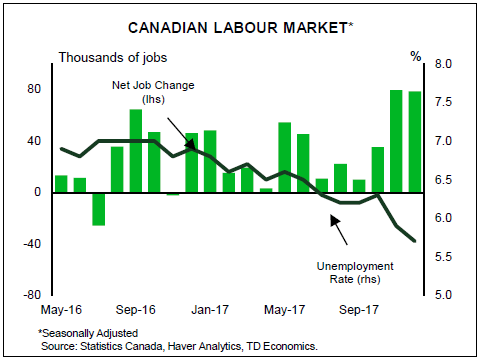U.S. Highlights
- Another week, another sell-off in the bond market. As of the time of writing the U.S. 10-year yield stood at over 2.8%, up more than 10 basis points from the end of last week.
- U.S. payrolls expanded by 200k in January while the unemployment rate remained steady at 4.1%. The big story though was the acceleration in wage growth. Average hourly earnings growth hit 2.9% year-on-year, up from 2.6% and the fastest growth since 2009.
- Recent economic data cement the case for the Federal Reserve to raise interest rates at its next meeting in March. Expect at least another two rate hikes from the Powell-led Fed before the end of 2018.
Canadian Highlights
- The TSX continued to sell-off this week with the composite benchmark tumbling to a 14-week low, making it one of the worst performing major bourses so far this year. The index was weighed on by the energy, utilities and telecoms sectors.
- Economic data was more positive, with real GDP advancing a solid 0.4% in November, boosted by a strong gain in the goods sector.
- The 6th round of NAFTA negotiations wrapped up early in the week, with a somewhat more optimistic tone emerging. Still, all sides remain far apart on many key issues with uncertainty likely to weigh on business investment as a result.
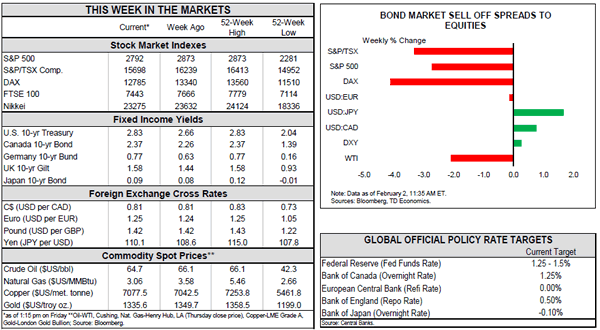
U.S. – Faster Growth + Inflation = Higher Bond Yields
Another week, another sell-off in the bond market. As of writing the U.S. 10-year yield stood at over 2.8%, up more than 10 basis points from the end of last week. Since the beginning of the year, the yield has risen over 40 basis points and now sits at its highest level since 2014.
The rise in yields is both a real growth and inflation story. On the real side, the sell-off has come as the median Bloomberg forecast for 2018 real GDP moved up 30 basis points to 2.6%, from 2.3% last October. Undoubtedly, tax cuts played a role. The biggest increases came as they were announced and then passed into law.
On the inflation side, market-based measures of inflation expectations have also moved up. The five-year forward inflation rate (an indicator of expectations for inflation five-to-ten years from now) has moved up over 20 basis points since the start of the year (Chart 1). Tax cuts are expected to push economic growth further above its trend rate and also increase the supply of Treasury securities, even as the economy approaches full employment.
Bond market moves have also been supported by economic data. Most relevant, the job market shows little signs of slowing. Job growth in January hit the 200k mark, ahead of the 181k per month averaged over the course of 2017. What’s more, wage growth accelerated noticeably to 2.9% year-on-year, from 2.7% in December (Chart 2). The rise in compensation is evident in other metrics as well. The employment cost index (ECI) rose to 2.7% (from 2.5%) year-on-year in the fourth quarter, while compensation per hour in the productivity and costs (PLC) data jumped to 2.2% (from 0.9%).
The acceleration in wage growth will come as a relief to believers in the Phillips curve, giving credence to the notion that as workers become scarce, the wages offered to attract and retain them should rise. At the same time, recent data have also shown the importance of "shadow slack." While the unemployment rate has been fairly steady, the employment to population ratio of 25 to 54 year olds has moved higher (it edged down ever so slightly in January to 79.0% from a cycle high of 79.1%). Still, its steady improvement is more consistent with the gradual rise in wage growth than the unemployment rate alone.
The increase in bond yields over the start of 2018 makes sense given these cyclical dynamics. Still, we would caution about extrapolating recent moves much further going forward. While the economic data support an ongoing expansion, the structural forces weighing on interest rates have not changed. Population aging will continue to exert downward pressure on the economy’s trend growth rate and the terminal (or neutral) level of the federal funds fate. At the same time, continued pressure on global bond yields from elevated debt levels and structural impediments to growth will keep a lid on U.S. yields.
All told, economic data and fiscal policy developments cement the case for the Federal Reserve to continue to normalize policy. Still, with a neutral rate in the neighborhood of 2.5%, three hikes in 2018 should be more than sufficient to keep a lid on inflation and allow any remaining labor market slack to be absorbed.
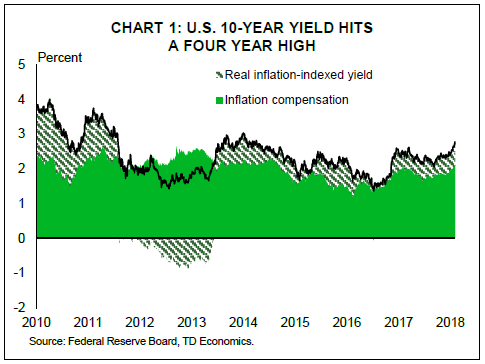
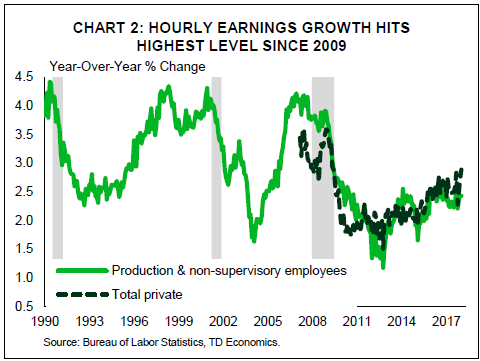
Canada – Economy on Good Footing But Risks Remain
The TSX sell-off continued this week, with the composite benchmark tumbling to a 14-week low, making it one of the worst performing major bourses so far this year. The energy sector was the main drag, weighed down by natural gas prices with Henry Hub futures down nearly 20%. The rise in WTI crude oil prices was also of little help for the loonie, given the spread to the WCS benchmark, which widened by nearly $3 to $30.50. But, the pain wasn’t confined to the energy sector, with rate-sensitive telecom and utilities sectors also sharply lower as Canadian bonds sold-off in lockstep with their U.S. counterparts. The loonie gained some ground early in the week, but more than gave up those gains following the solid U.S. payroll report which telegraphed strong hiring and rapidly rising wages south of the border.
In contrast to the bourses, Canadian economic data released this week painted a positive picture of the underlying economy. Real GDP advanced by a solid 0.4% in November, boosted by a rebound in the goods sector (Chart 1). Manufacturing output surged as production resumed at several major auto plants following earlier shutdowns. Not to be outdone, the services sector expanded for the 20th straight month. In fact, one of the most impressive aspects of the report was the breadth of the monthly gain (Chart 2), with wall-to-wall growth indicating that the economy was operating on all cylinders. Importantly, available data for December points to another solid month of growth, thanks to surging employment, a healthy gain in hours worked and firm housing activity. All told, November’s monthly gain, coupled with our expectations for a healthy December print, put the economy on track for a 2.4% annualized quarterly gain, representing another quarter of above-potential growth and indicating good momentum heading into 2018.
This week also marked the end of the 6th round of NAFTA negotiations and despite some gloomy headlines, the tone coming out of the talks appeared somewhat more optimistic. Indeed, the U.S. Trade Representative, Robert Lighthizer, noted that serious discussions finally began on core issues, with this round representing a positive step forward. With that said, no major decisions were made during this round, leaving plenty of work still ahead. Despite the cautiously optimistic tone that emerged, the latest round of negotiations doesn’t materially change our view of the balance of risks related to NAFTA. The final outcome of negotiations remains an open question and, until resolved, the uncertainty will continue to weigh on businesses, particularly north of the border. The next round of talks is currently scheduled to take place late this month in Mexico, before wrapping up in Washington the following month.
All in all, the robust GDP data should be viewed as constructive by the Bank of Canada, largely confirming their Q4 growth estimate. But, despite the cautiously optimistic tone struck during the NAFTA negotiations, the outcome remains highly uncertain. As such, events this week have done little to move the needle as far as the interest rate path is concerned, with the next hike unlikely to take place until the July fixed announcement date – assuming the outlook continues to evolve as expected.
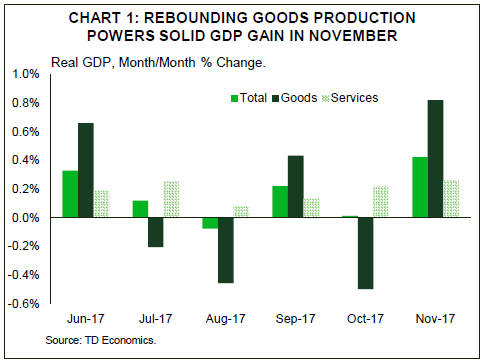
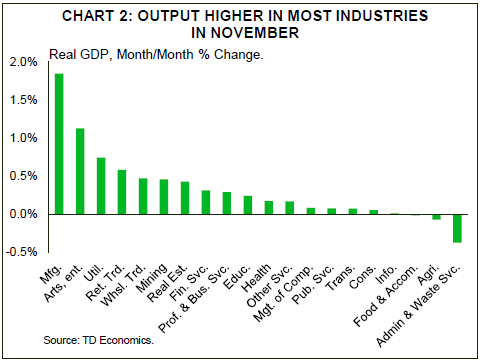
Canada: Upcoming Key Economic Releases
Canadian International Trade – December
Release Date: February 6, 2018
Previous Result: -$2.5bn
TD Forecast: -$2.0bn
Consensus: N/A
The international merchandise trade deficit is forecast to narrow to $2.0bn in November, reflecting a further recovery in non-energy exports. As presaged by US advance trade data, motor vehicle exports should provide the largest source of strength as production ramps up following plant shutdowns. Energy exports will be constrained by pipeline bottlenecks after a spill shutdown the Keystone pipeline for part of the month. Higher crude prices and increased rail shipments will provide a key offset to weaker pipeline volumes and as a result, nominal crude exports should be down more modestly on the month. On the other side of the spectrum, imports are likely to moderate from its previous jump, allowing for a narrowing in the deficit. We expect export volumes to reinforce an upbeat report.
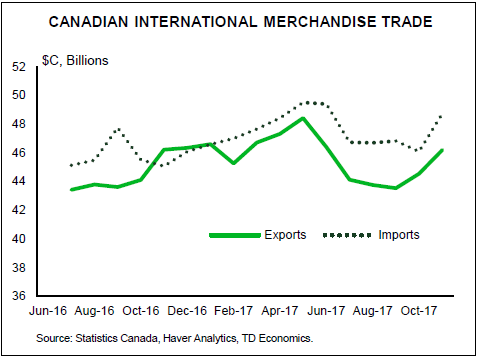
Canadian Employment – January
Release Date: February 9, 2018
Previous Result: 65k, unemployment rate: 5.8%
TD Forecast: -12k, unemployment rate: 5.8%
Consensus: -2k, 5.8%
We expect some give back in jobs to finally materialize in January and forecast a net loss of 12k. The pullback is coming off a string of over 12 months of consecutive gains, which have averaged 64k in Q4. The minimum wage hike in Ontario, which was implemented on January 1, should lead to job losses totaling 90k over the mid-term. As a result, we expect Ontario to underperform in January and drive the net loss of jobs. Consistent with the slowdown in employment, we expect the unemployment rate to rise to 5.8%. Offsetting the weakness in jobs will be wage growth, where we anticipate a significant jump in average hourly earnings from the 22% increase in the Ontario minimum wage. We look for average hourly earnings of permanent employees, our preferred measure, to jump to 4% y/y from 2.9% y/y in December. So the LFS report should send mixed signals and markets could be grappling with weakness in jobs but a surge in wage growth on account of the Ontario minimum wage hike. Because we see wages as a lagging indicator relative to jobs, and because the monthly surge in wages will be largely driven by a one-off policy adjustment, we expect the Bank to be concerned by the underlying trends in the labour market and focus more on jobs this month.
